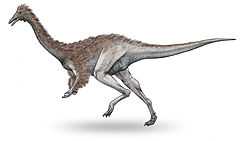Garudimimus
| Garudimimus Temporal range: Late Cretaceous,[1] 98–83Ma | |
|---|---|
 | |
| Scientific classification | |
| Kingdom: | Animalia |
| Phylum: | Chordata |
| Clade: | Dinosauria |
| Suborder: | Theropoda |
| Clade: | †Ornithomimosauria |
| Family: | †Deinocheiridae |
| Genus: | †Garudimimus Barsbold, 1981 |
| Species: | † G. brevipes |
| Binomial name | |
| Garudimimus brevipes Barsbold, 1981 | |
Garudimimus ("Garuda mimic") is a basal ornithomimosaurian theropod dinosaur from the Upper Cretaceous of Mongolia.
Discovery and naming

In 1981, during a Soviet-Mongolian expedition to the Gobi Desert, a theropod skeleton was discovered at Baishin Tsav in Ömnögovi Province. The same year this specimen was named and described by Rinchen Barsbold as the type species Garudimimus brevipes. The generic name combines a reference to the Garuda, winged creatures from Mongolian Buddhist mythology, with a Latin mimus, "mimic". The specific name is derived from Latin brevis, "short", and pes, "foot", referring to the short metatarsus.[2]
The holotype specimen, GIN 100/13, was uncovered in sediments of the Upper Cretaceous Bayan Shireh Formation the stratification of which is uncertain; its possible age ranges from the Cenomanian to the Campanian. It consists of a rather complete and articulated skeleton including the skull but lacking the shoulder girdle, forelimbs and tail end, of a subadult individual. The specimen is today usually seen as the only fossil known of Garudimimus, though Philip J. Currie once claimed that part of the Archaeornithomimus material belonged to Garudimimus. The skeleton was for the first time described in detail in works by Yoshitsugu Kobayashi from 2004[3] and 2005.[4]
Description
Garudimimus was a rather small ornithomimosaur. In 2010, Gregory S. Paul estimated its adult length at 2.5 metres (8.2 ft), the weight at thirty kilogrammes (66 lbs).[5] The length of the femur is 371 millimetres.[4]
Garudimimus, an early ornithomimosaurian, appears to have not been as adapted for speed as more derived ornithomimids. It had relatively short legs, heavy feet, and in the hip, shorter ilia, the latter indicating that the musculature of the legs was not as well-developed as in most ornithomimids. The foot had four toes and a vestige of the first digit, whereas all (other) ornithomimids were three-toed with the first and fifth toe lost. The toothless skull has very straight jaws ending in a more rounded snout tip than that of others of the group, and larger eyes.[6]
It was previously thought that this "primitive" member of Ornithomimosauria possessed a lacrimal horn at the top of the skull, in front of the eye socket. However, recent studies have shown that this "horn" was simply the shifted pointed back end of the nasal bone.[4] Another early mistake was the suggestion by Thomas Holtz that the foot had been incorrectly reconstructed and would in fact have been arctometatarsalian, with the top of the third metatarsal excluded from the front surface of the metatarsus, proving a close relationship of the Ornithomimosauria with the Tyrannosauroidea which show the same condition. Kobayashi concluded that the original description of Barsbold had been correct on this point.[4]
Phylogeny
In 1981, Barbold assigned Garudimimus to a separate Garudimimidae. Modern cladistic analyses recover either a basal position in the Ornithomimosauria close to the Ornithomimidae or a basal position in the Ornithomimidae itself. In 2014 Garudimimus was recovered as a sister taxon to Deinocheirus by Yuong-Nam Lee et al. and assigned Garudimimus to the family Deinocheiridae, synonymising Garudimimidae with Deinocheiridae.[1]
Paleobiology
Garudimimus may have been an omnivore.
Comparisons between the scleral rings of Garudimimus and modern birds and reptiles indicate that it may have been cathemeral, active throughout the day at short intervals.[7]
References
- ↑ 1.0 1.1 Yuong-Nam Lee, Rinchen Barsbold, Philip J. Currie, Yoshitsugu Kobayashi, Hang-Jae Lee, Pascal Godefroit, François Escuillié & Tsogtbaatar Chinzorig (2014) "Resolving the long-standing enigmas of a giant ornithomimosaur Deinocheirus mirificus". Nature (advance online publication) doi:10.1038/nature13874.
- ↑ Barsbold, Rinchen (1981). "Bezzubyye khishchnyye dinozavry Mongolii", Sovmestnaia Sovetsko-Mongol'skaia Paleontologicheskaia Ekspeditsiia". Trudy 15: 28–39.
- ↑ Kobayashi, Y., 2004, Asian ornithomimosaurs. PhD Thesis, Southern Methodist University. 340 pp
- ↑ 4.0 4.1 4.2 4.3 Kobayashi, Y.; Barsbold, R. (2005). "Reexamination of a primitive ornithomimosaur, Garudimimus brevipes Barsbold, 1981 (Dinosauria:Theropoda), from the Late Cretaceous of Mongolia". Canadian Journal of Earth Sciences 42: 1501–1521. doi:10.1139/e05-044.
- ↑ Paul, G.S., 2010, The Princeton Field Guide to Dinosaurs, Princeton University Press p. 112
- ↑ Dixon, Dougal (2006). The Complete Book of Dinosaurs. London: Hermes House. p. 190. ISBN 0-681-37578-7.
- ↑ Schmitz, L.; Motani, R. (2011). "Nocturnality in Dinosaurs Inferred from Scleral Ring and Orbit Morphology". Science 332 (6030): 705–8. doi:10.1126/science.1200043. PMID 21493820.